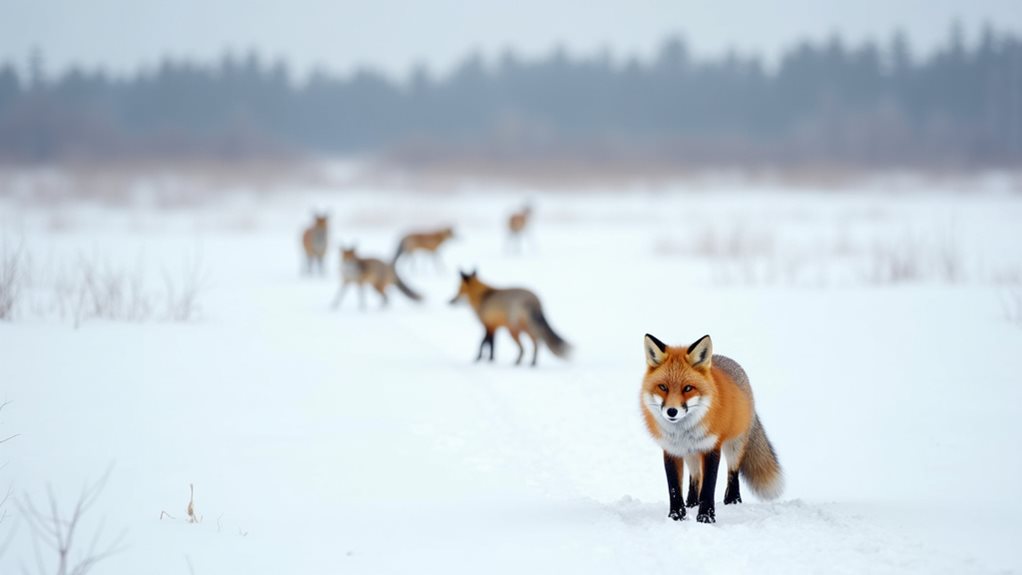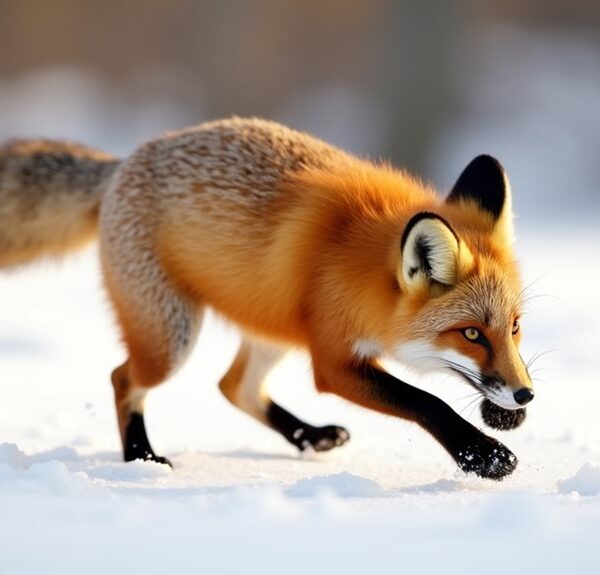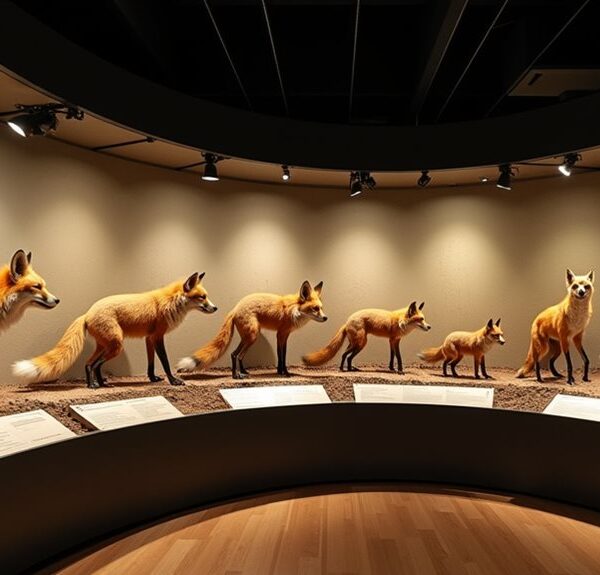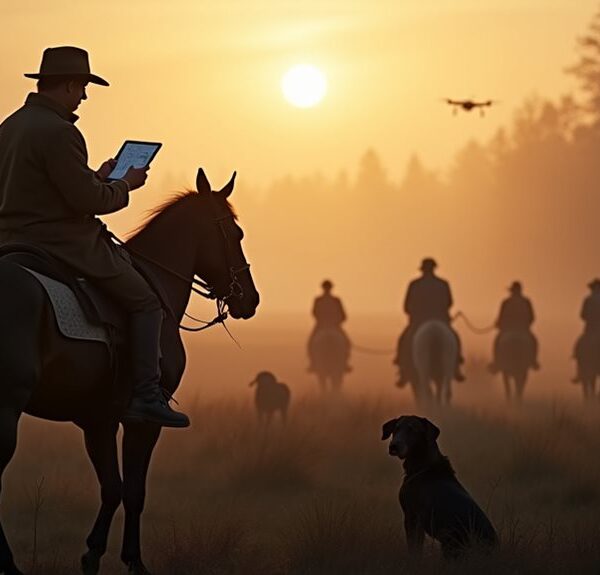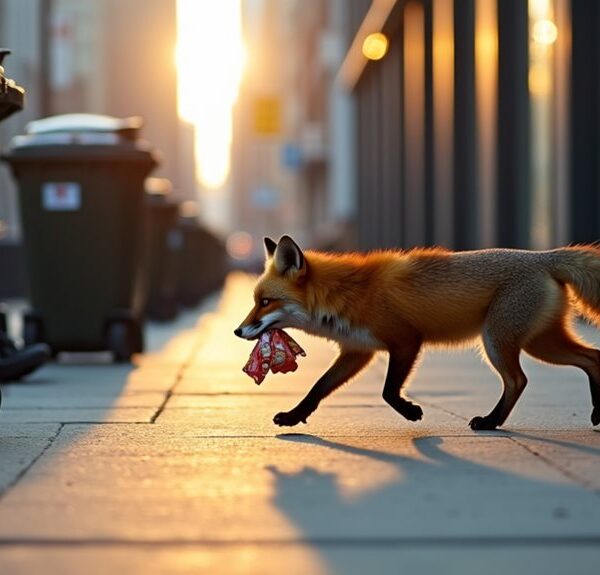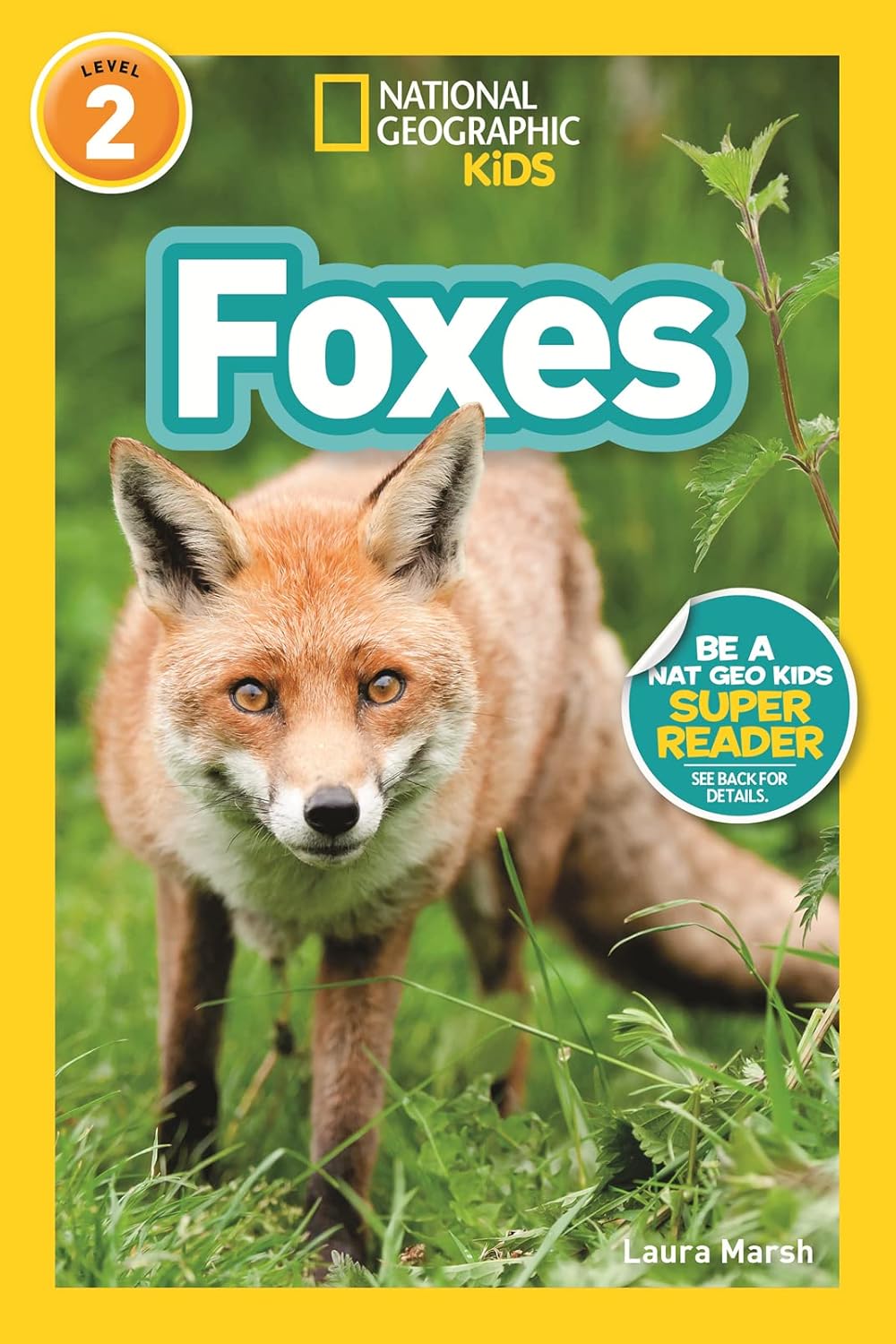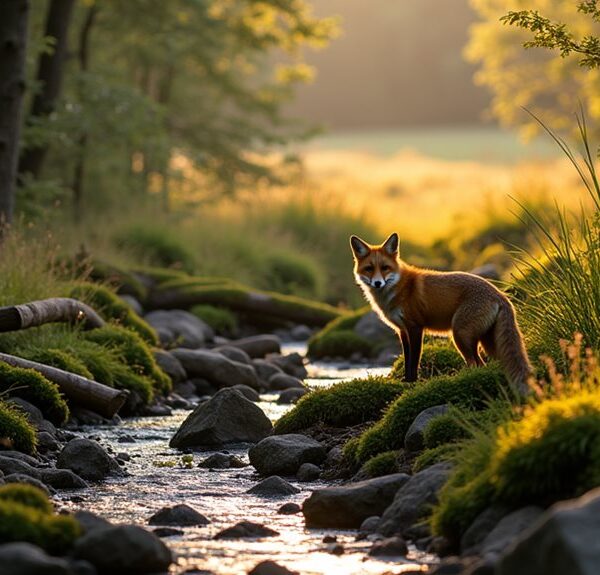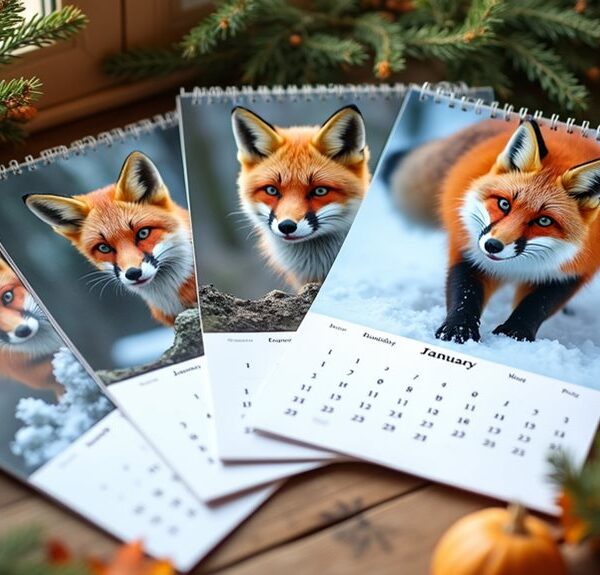Fox migration patterns vary dramatically across North America. You’ll find Arctic foxes traveling up to 100 miles daily while urban foxes restrict their movement to just a few city blocks. Northern foxes roam 20 square miles during harsh winters, while eastern woodland foxes stay close together in family groups. Climate change is forcing them to seek higher elevations and adjust traditional routes. These resilient creatures adapt their movements based on food availability, human development, and seasonal changes in their diverse habitats.
Contents
- 1 Regional Variations in Fox Movement Across North American Habitats
- 2 Arctic Fox Migration: Seasonal Journeys in the Northern Territories
- 3 Red Fox Adaptations: Urban Settlement vs. Rural Roaming
- 4 Climate Change Impact on Traditional Fox Travel Routes
- 5 Food Source Availability and Its Influence on Migration Decisions
- 6 Tracking Technologies Revealing New Fox Movement Patterns
- 7 Conservation Implications of Shifting Fox Territories
- 8 Final Thoughts
Regional Variations in Fox Movement Across North American Habitats
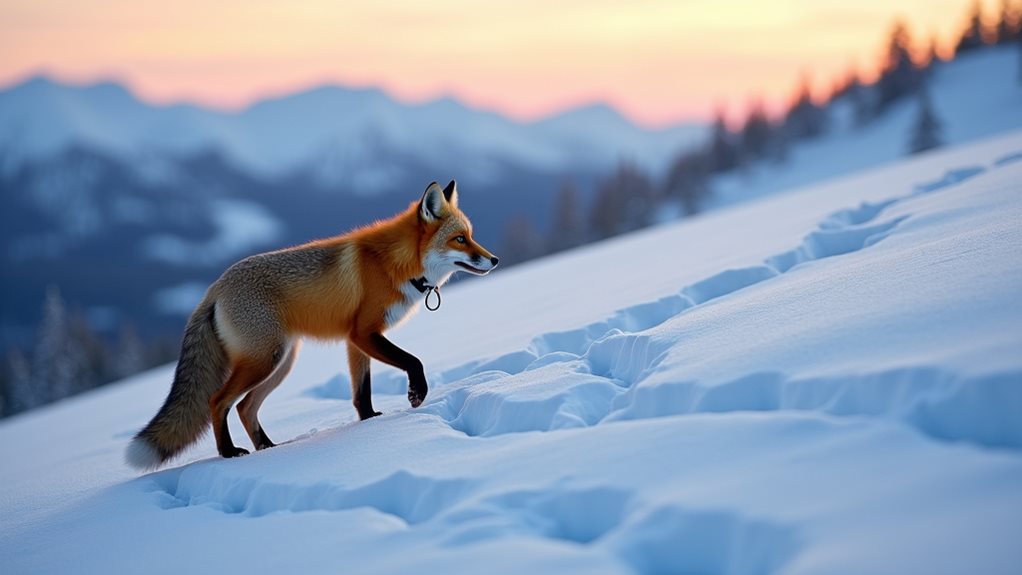
When you observe foxes across North America, you’ll notice they don’t follow one standard playbook for movement. These clever creatures adapt their travel patterns based on where they call home.
In northern regions, you’ll find foxes traveling greater distances during harsh winters, often seeking food across territories spanning up to 20 square miles. Fox socialization plays a key role too—family groups in eastern woodlands stay relatively close, while desert foxes spread out to avoid competition.
Harsh winters push northern foxes across vast territories, while woodland families huddle close and desert kin scatter widely.
Their habitat preferences directly impact movement patterns. Forest-dwelling foxes establish smaller, resource-rich territories, while those in open plains cover more ground. Additionally, urban adaptability has allowed foxes to thrive in cities, resulting in reduced movement as they find sustenance nearby.
Urban foxes? They’ve become neighborhood locals, rarely venturing beyond a few city blocks. The mountains present yet another story, with seasonal vertical migrations following food availability.
Arctic Fox Migration: Seasonal Journeys in the Northern Territories
Among North American foxes, none demonstrate more remarkable travel capabilities than the Arctic fox.
You’ll find these resilient creatures traversing vast tundra terrains during their seasonal expeditions across the northern territories. Arctic foxes can travel up to 100 miles daily when food becomes scarce, following unpredictable migration routes that respond to lemming population cycles.
Unlike their southern relatives, arctic foxes don’t follow consistent patterns each year. You might spot them moving in completely different directions depending on prey availability.
Their remarkable adaptation allows them to survive temperatures as low as -58°F while searching for food! This adaptability is complemented by their double-layered fur coat, which provides exceptional insulation against the cold.
Their white winter coats provide perfect camouflage as they trek across snow-covered terrains.
When you’re observing these fascinating creatures, you’re witnessing one of nature’s most impressive survival strategies in action.
Red Fox Adaptations: Urban Settlement vs. Rural Roaming
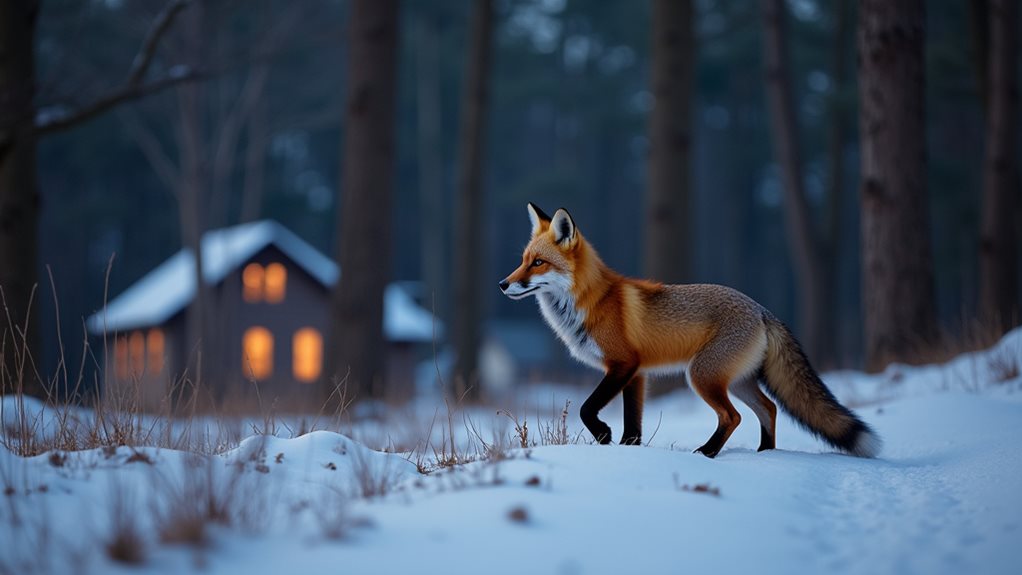
Unlike their arctic cousins who set out on epic voyages, red foxes demonstrate remarkable adaptability in their movement patterns between urban and rural environments.
You’ll notice these clever canids have mastered both worlds, shifting their behaviors to match their surroundings.
- Urban foxes often establish smaller territories (1-2 square miles) compared to their rural counterparts.
- They’ve developed nocturnal patterns in cities to avoid human interaction.
- Rural behavior includes extensive roaming, covering up to 5 miles daily in search of food.
- Urban adaptation includes a diet shift toward human food waste and small pets.
- Fox families in both settings maintain den sites, but urban foxes often choose unusual locations like under decks or sheds.
These dynamic adaptations are indicative of urban fox resilience, illustrating how they thrive in changing environments alongside human populations.
You’re witnessing evolution in action as these resourceful animals rewrite their ancient rural behaviors to thrive alongside us.
Climate Change Impact on Traditional Fox Travel Routes
While red foxes demonstrate impressive adaptability to human environments, their wild relatives now face a more formidable challenge: climate change.
You’ll notice these clever creatures struggling as their traditional travel routes disappear before their eyes. Rising temperatures force foxes to seek higher elevations and more northern territories, disrupting centuries-old migration patterns.
Habitat fragmentation impacts fox populations dramatically, cutting off access to food sources and potential mates.
When highways and developments slice through migration corridors, foxes must develop new climate adaptation strategies quickly. They’re learning to travel at night when it’s cooler, change their diets to include unfamiliar prey, and establish territories in previously uninhabitable areas. The increase in competition from invasive red foxes further complicates their survival in these changing conditions.
Next time you spot a fox in an unexpected place, remember—it’s likely not merely exploring, but actively adapting to our rapidly changing world.
Food Source Availability and Its Influence on Migration Decisions
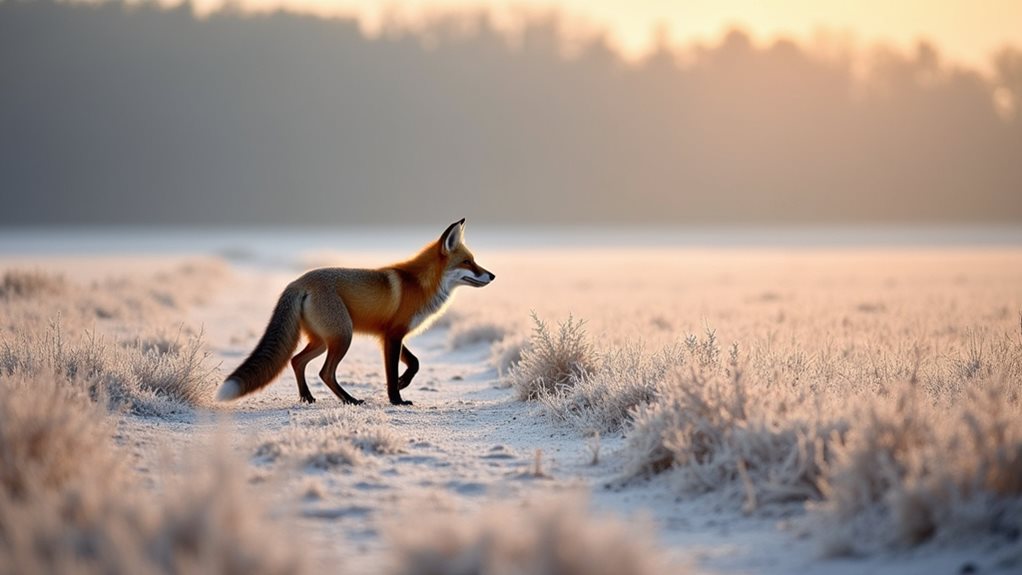
You’ll notice how foxes follow the food, adjusting their migration patterns according to where prey is most abundant throughout the year.
In winter and fall, you might spot them traveling to areas with higher rodent populations, while spring brings movements toward bird nesting grounds and newly emerging food sources.
Their remarkable ability to adapt includes venturing into suburban and urban environments, where they’ve learned to capitalize on human-associated food resources like garbage, pet food, and the rodents attracted to our settlements. This adaptability is especially evident in urban foxes, which can consume human food waste and thrive in environments with easy access to food sources.
Prey Density Variations
Foxes make migration decisions largely based on food availability, with prey density serving as the primary catalyst for seasonal movements.
You’ll notice these clever creatures follow prey abundance patterns across different terrains, adapting their movements to maximize hunting success. When local food sources diminish, they’ll travel surprising distances to find more productive hunting grounds.
- Spring brings rodent population booms, drawing foxes to meadows and fields
- Summer sees foxes utilizing forest edges where prey diversity peaks
- Fall migration often coincides with bird migrations and pre-winter prey activity
- Winter scarcity pushes foxes toward human settlements when habitat fragmentation limits options
- Coastal foxes follow tideline food availability, creating unique migration patterns
This dynamic relationship between predator and prey creates the fascinating movement tapestry you’ll observe in North American fox populations. Fox species such as the gray fox exhibit remarkable adaptability, further influencing regional migration trends.
Seasonal Food Availability
Seasonal food availability creates dramatic shifts in fox migration patterns throughout North America, influencing not just when they move but also where they’ll establish territories.
You’ll notice foxes adjust their movements based on what’s currently on nature’s menu. During summer abundance, they’ll stay put where berries, insects, and small mammals thrive.
When winter arrives, their dietary preferences drive them toward human settlements or lower elevations where food remains accessible.
Habitat influences these decisions greatly – foxes in agricultural regions might follow harvest cycles, while their woodland cousins track rodent population booms.
You might spot a fox traveling up to 20 miles to find a new food source when seasonal scarcity hits! This extraordinary adaptability explains why you’ll find these clever creatures thriving in such diverse North American ecosystems. Additionally, berries as a food source play a vital role in their diet, especially during the autumn months when small mammal availability is low.
Urban Resource Adaptation
While natural habitats continue to shrink across the continent, red and gray foxes have demonstrated remarkable flexibility in adapting to urban environments throughout North America.
You’ll notice these clever canids have altered their migration patterns based on the reliable resources our cities provide.
Their urban habitat adaptation includes:
- Establishing dens in parks, golf courses, and even residential yards
- Shifting to nocturnal activity to avoid human interaction
- Developing specialized scavenging behavior around restaurants and trash collection sites
- Expanding their diet to include pet food, discarded human food, and urban rodents
- Creating smaller, more permanent territories than their rural counterparts
This adaptability means you’re likely to spot resident fox populations year-round in many North American cities, as the need for seasonal migration diminishes when consistent food sources are available. Communities’ educational programs about urban fox behavior can further enhance these animals’ successful coexistence with residents.
Tracking Technologies Revealing New Fox Movement Patterns
Modern tracking technologies have revolutionized our understanding of fox behavior across North America.
You’ll be amazed how GPS collars and satellite tracking methods have transformed wildlife research, offering unparalleled insights into fox movement patterns that were once invisible to scientists.
These advanced tracking methods reveal that foxes don’t just wander randomly—they follow sophisticated routes based on seasonal changes and food availability.
Movement analysis shows they’ll travel up to 10 miles daily when hunting, but they’re surprisingly loyal to their established territories during breeding season.
You’re witnessing science in action as researchers combine data from multiple tracking systems to create detailed maps of fox migration.
It’s like having a fox’s personal diary open before your eyes, showing when they’ll venture into new territories and when they’ll hunker down at home.
Conservation Implications of Shifting Fox Territories
As habitat fragmentation accelerates across North America, conservation efforts must adapt to the shifting territories of fox populations.
You’ll notice these beautiful creatures facing unprecedented challenges as their habitats shrink. Territory conflict becomes inevitable when foxes can’t find enough space to thrive, often pushing them into dangerous human-populated areas.
Conservation programs are evolving to address these challenges:
Adaptation is the cornerstone of modern conservation, as programs evolve to meet the complex challenges facing our fox populations.
- Creating wildlife corridors to connect fragmented habitats
- Implementing urban fox management strategies to reduce human-wildlife conflict
- Educating communities about coexisting with local fox populations
- Restoring native vegetation that supports fox prey species
- Monitoring territory shifts to predict future conservation needs
Furthermore, preserving natural spaces is crucial for the survival of foxes as they adapt to changing environments.
When you support these initiatives, you’re helping foxes maintain their natural behaviors despite habitat fragmentation.
Their adaptability is remarkable, but they still need your help to steer through our changing environment.
Final Thoughts
You’ve seen how fox migration patterns dramatically differ across North America’s diverse environments. While Arctic foxes travel up to 2,700 miles annually—the longest terrestrial migration of any canid species—their southern red fox cousins often establish permanent territories of just 5-10 square miles. As climate change continues to reshape habitats, you’ll notice these adaptable creatures adjusting their movement patterns accordingly. Understanding these changes isn’t just fascinating—it’s vital for conservation efforts protecting these resourceful animals.

